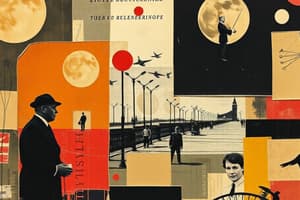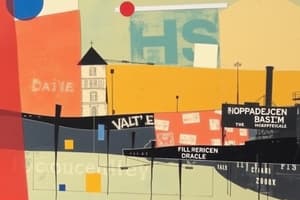Podcast
Questions and Answers
Which function of art primarily provides beauty and pleasurable experiences?
Which function of art primarily provides beauty and pleasurable experiences?
- Aesthetic (correct)
- Psychological
- Cultural
- Political
Which major art movement is characterized by dramatic use of light and emotional intensity?
Which major art movement is characterized by dramatic use of light and emotional intensity?
- Modernism
- Renaissance
- Baroque (correct)
- Impressionism
What key element of art is primarily concerned with evoking emotions through hue, saturation, and brightness?
What key element of art is primarily concerned with evoking emotions through hue, saturation, and brightness?
- Color (correct)
- Form
- Value
- Line
Which artistic technique uses materials like stone, metal, and clay for creation?
Which artistic technique uses materials like stone, metal, and clay for creation?
Which artist is renowned for the painting 'Mona Lisa'?
Which artist is renowned for the painting 'Mona Lisa'?
What art movement emphasizes individualism and emotion, particularly from the late 18th to 19th century?
What art movement emphasizes individualism and emotion, particularly from the late 18th to 19th century?
Which of the following techniques involves capturing images through chemical or digital processes?
Which of the following techniques involves capturing images through chemical or digital processes?
What is the primary focus of Impressionism as an art movement?
What is the primary focus of Impressionism as an art movement?
Study Notes
Definition of Art
- Expression or application of human creative skill and imagination.
- Often manifested in visual forms like painting, sculpture, and architecture.
- Can also include performing arts (music, theater, dance) and literary arts (poetry, prose).
Functions of Art
- Aesthetic: Provides beauty and pleasurable experiences.
- Communicative: Conveys ideas, emotions, and narratives.
- Cultural: Reflects societal values and influences cultural identity.
- Psychological: Offers therapeutic benefits through expression and reflection.
- Political: Acts as a commentary or critique on societal issues and power structures.
Major Art Movements
- Renaissance (14th-17th century): Emphasis on humanism, perspective, and classical themes.
- Baroque (17th-18th century): Dramatic use of light and color, emotional intensity.
- Romanticism (late 18th-19th century): Focus on emotion, individualism, and nature.
- Impressionism (late 19th century): Capture of light and momentary scenes, brush strokes visible.
- Modernism (late 19th-20th century): Break from traditional forms, experimentation with styles and materials.
- Postmodernism (mid-20th century onwards): Diverse and eclectic, often challenging concepts of originality and authorship.
Key Elements of Art
- Line: The basic element; can create shapes, outlines, and textures.
- Color: Evokes emotions; consists of hue, saturation, and brightness.
- Form: Three-dimensional, exhibiting volume and mass.
- Texture: Surface quality perceived through touch or sight.
- Space: The area around, above, and within objects; includes positive and negative space.
- Value: The lightness or darkness of a color; helps create depth.
Artistic Techniques and Media
- Painting: Oil, watercolor, acrylic, fresco, and gouache.
- Drawing: Pencil, charcoal, ink, and pastels.
- Sculpture: Carving, modeling, casting, and assembling materials like stone, metal, and clay.
- Printmaking: Techniques include etching, lithography, and screen printing.
- Photography: Capturing images through chemical or digital processes.
Notable Artists
- Leonardo da Vinci: Known for his diverse talents and works like the "Mona Lisa."
- Vincent van Gogh: Post-impressionist, famous for his emotive use of color and expressive brushwork.
- Pablo Picasso: Co-founder of Cubism; known for works like "Guernica."
- Frida Kahlo: Known for her self-portraits and exploration of identity and pain.
- Andy Warhol: Leading figure in the Pop Art movement, famous for his works on consumer culture.
Impact of Art
- Can influence societal change and raise awareness on various issues.
- Serves as a historical document reflecting societal changes and cultural heritage.
- Continues to evolve with technology, leading to digital art, installations, and interactive pieces.
Definition of Art
- Art involves human creative skill and imagination, often seen in visual forms like painting, sculpture, and architecture.
- Art also encompasses performing arts like music, theater, and dance, as well as literary arts like poetry and prose.
Functions of Art
- Art serves aesthetic purposes by providing beauty and pleasurable experiences.
- The communicative function of art allows it to convey ideas, emotions, and narratives.
- Art reflects societal values and influences cultural identity through its cultural function.
- Art can offer therapeutic benefits through expression and reflection, fulfilling its psychological function.
- The political function of art allows it to act as a commentary or critique on societal issues and power structures.
Major Art Movements
- The Renaissance (14th-17th century) emphasized humanism, perspective, and classical themes.
- The Baroque period (17th-18th century) was known for its dramatic use of light and color, and its portrayal of emotional intensity.
- Romanticism (late 18th-19th century) focused on emotions, individualism, and the depiction of nature.
- Impressionism (late 19th century) aimed to capture light and momentary scenes, characterized by visible brushstrokes.
- Modernism (late 19th-20th century) broke from traditional forms, experimenting with styles and materials.
- Postmodernism (mid-20th century onwards) is diverse and eclectic, often challenging concepts of originality and authorship.
Key Elements of Art
- Line is a fundamental element, used to create shapes, outlines, and textures.
- Color evokes emotions and consists of hue, saturation, and brightness.
- Form refers to three-dimensional objects exhibiting volume and mass.
- Texture describes the surface quality perceived through touch or sight.
- Space encompasses the area surrounding, above, and within objects, including positive and negative space.
- Value refers to the lightness or darkness of a color, contributing to depth perception.
Artistic Techniques and Media
- Painting techniques include oil, watercolor, acrylic, fresco, and gouache.
- Drawing is done using pencils, charcoal, ink, and pastels.
- Sculpture is created through carving, modeling, casting, and assembling materials like stone, metal, and clay.
- Printmaking techniques encompass etching, lithography, and screen printing.
- Photography captures images through chemical or digital processes.
Notable Artists
- Leonardo da Vinci was renowned for his diverse talents and works like the "Mona Lisa."
- Vincent van Gogh, a post-impressionist, was famous for his emotive use of color and expressive brushwork.
- Pablo Picasso, a co-founder of Cubism, is known for works like "Guernica".
- Frida Kahlo explored identity and pain through her self-portraits.
- Andy Warhol, a leading figure in the Pop Art movement, created works about consumer culture.
Impact of Art
- Art can influence societal change and raise awareness about various issues.
- It serves as a historical document reflecting societal changes and cultural heritage.
- The evolution of art incorporates technology, resulting in digital art, installations, and interactive pieces.
Studying That Suits You
Use AI to generate personalized quizzes and flashcards to suit your learning preferences.
Description
Explore the definition, functions, and major movements of art. This quiz covers the aesthetic, communicative, cultural, psychological, and political functions of art, along with important art movements like Renaissance, Baroque, Romanticism, and Impressionism.




